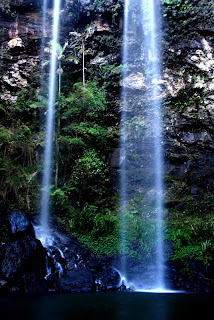
Only the second koala we have seen in the wild. He (note the ears) was at Binna Burra in Springbrook Nat'l Park. Ironically, he was in a grove of trees slated for cutting to build 'investment properties' on a private inholding.

This is a typical view of a Riflebird. As stated in Morcombe's bird guide, "the three Australian Riflebirds have similar plumages, differing in detail that might not be evident when, from far below, one is seen as a silhouette against the sky. But once recognized as 'a riflebird,' its location, checked against the Riflebird maps, may be the best guide to species."
Since it is a riflebird and it is here, ipso facto - this is a Paradise Riflebird who (take our word for it) has a "triangular gorget of iridescent metallic colours that change with every movement of the bird."
 A more cooperative female Riflebird showing her long white brow.
A more cooperative female Riflebird showing her long white brow.
A Wompoo Fruit Dove tests the extent of Dirk's lens. They stay pretty high (like really far away!) in the canopy and are generally pretty hard to spot, but as Morcombe notes, their call is "powerful, deep, reverberating, as in the name 'wom-poo,' but the first part is like the 'plonk' of a rock dropped in deep water: 'g'lonk-ooo,' or 'wollocka-roo.' A difficult to miss noise in the rainforest!
 We are thinking of developing a definitive guide to identification of birds when one can only see the birds buttt! Here's shy Mr. Wompoo's butt, (or bum, as they are know here) finally turns to look at me.
We are thinking of developing a definitive guide to identification of birds when one can only see the birds buttt! Here's shy Mr. Wompoo's butt, (or bum, as they are know here) finally turns to look at me.
Even though it is autumn some gardens are blooming. So we hung out at unoccupied vacation place in the Springbrook Nat'l Park spying on the birds. Lots of little very flitty birds and this one boldly colored Eastern Spinebill.
 A Yellow-tailed Black-Cockatoo peering through the Springbrook forest at us, in between bark shredding. We could also hear these guys from far away, with their "carrying, wailing calls, 'why-eela, weela.'"(which go on, and on, nad on....). The red eye-ring and dark bill distinguishes the guys from the girls. They were simply shredding the bark off this tree.
A Yellow-tailed Black-Cockatoo peering through the Springbrook forest at us, in between bark shredding. We could also hear these guys from far away, with their "carrying, wailing calls, 'why-eela, weela.'"(which go on, and on, nad on....). The red eye-ring and dark bill distinguishes the guys from the girls. They were simply shredding the bark off this tree. A female Australian Wood Duck in a small park near Currumbin, displaying her stylish black and white chequered front. She cooperated with Morcombe's advice that she "must be seen at close range for the delicately patterned beauty of its [her] plumage to be appreciated."
A female Australian Wood Duck in a small park near Currumbin, displaying her stylish black and white chequered front. She cooperated with Morcombe's advice that she "must be seen at close range for the delicately patterned beauty of its [her] plumage to be appreciated." We know this is a non-breeding Great Egret because of his lack of plumes and a long, kinked neck. Also, the "length of head and neck together, outstretched, is great than the body length." In the pond near Currumbin.
We know this is a non-breeding Great Egret because of his lack of plumes and a long, kinked neck. Also, the "length of head and neck together, outstretched, is great than the body length." In the pond near Currumbin.
An Eastern Water Dragon hanging out in the same park near Currumbin.

A Lace Monitor checking out our picnic at Binna Burra distracting us from the wily Bush Turkeys who stole our apple... this guy was a little over a meter long...

Twin Falls in Springbrook

Rainbow Falls in Lamington National park
.jpg) Lovely light through the canopy at lower Ballanjui Fall in Lamington kept Dirk busy trying to find the perfect rainbow and water combination.
Lovely light through the canopy at lower Ballanjui Fall in Lamington kept Dirk busy trying to find the perfect rainbow and water combination..jpg) Finally, the NYT had a 'picturing the world event (see http://www.nytimes.com/
Finally, the NYT had a 'picturing the world event (see http://www.nytimes.com/
1 comment:
Egggzellent post D&N! Great bird and critter pics. Looks like a lot of fun down there!
Post a Comment